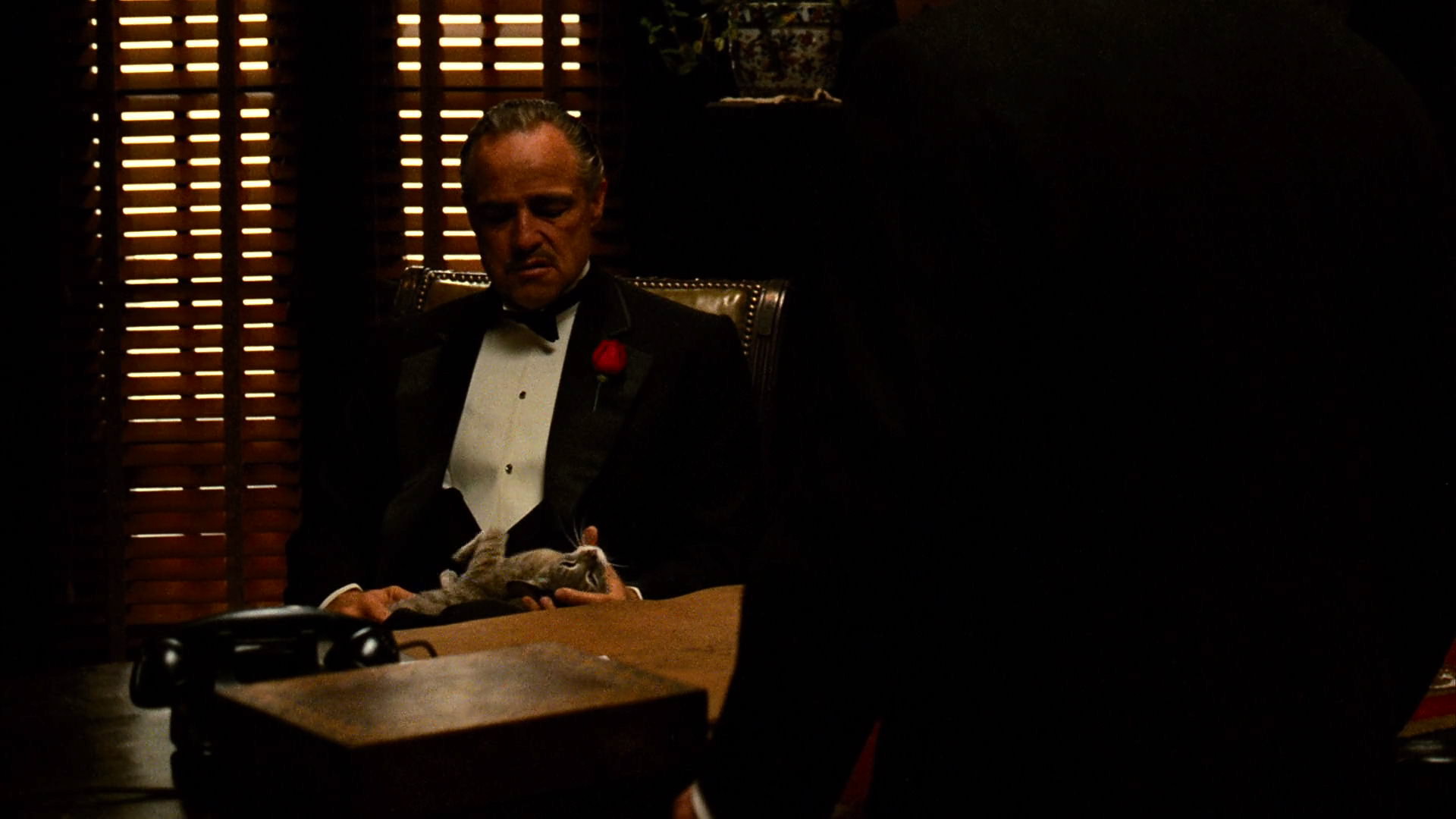by Nathaniel R

Our film title this week on Hit Me With Your Best Shot was in honor of the restoration of The Godfather (1972) for its 50th Anniversary. Here are the Best Shot choices from seven participants and my own towards the end of the post. Click on the images that follow to read the corresponding articles. I'll be "talking" inbetween the images about a film I've never written about before (!) as I select my own...
Alexander Georgakis choice on twitter (thread)
I, too, adore this shot. The entire opening setpiece of Connie's wedding is a marvel of contrasts. It crosscuts between brightly lit and festive familial wide shots like the one Alex selected and darkly lit, even sinister, exchanges in Vito Corleone's (Marlon Brando) private office nearby. My favourite image from this sequence is the one up top with Vito stroking his cat. Lots of people pet their dogs and cats at home; it only feels idiosyncratic and character-driven because the words (violent) and the images (tender) are at odds and also because movies so rarely display such authenticity when they get 'intimate'.
The shot above is most interesting, though, in the way it parallels an earlier shot where the family gathers fro the group photo only for Vito to abandon it because Michael (Al Pacino) hasn't arrived. It's a small detail but it conveys so much about Vito's respect for Michael... even this father's respect for the distance his son keeps. Michael's chosen to be a "civilian" and not part of the family business.
Cláudio's choice at The Film Experience (article)
Ryan's choice on Twitter (thread) -- he'd never seen The Godfather before!
The cinematography by Gordon Willis is a marvel, though it wasn't embraced as such at the time even though the film itself was an immediate blockbuster and critical success. Though it's a handsome picture with many astute choices in lighting and composition, one of the things to admire most about it is how measured and calm it is for most of its three hours. For a picture with such a high body count it's incongruously sedate, the violence only coming in very short bursts and half the time obscured from our view (as in Cláudio and Ryan's choices above). Only occassionally is the violence in our full view. Either way the murders always feel shocking even if you've already seen the picture, because they disrupt such steady placcid images.
But the thing I personally find most fascinating about the picture is Michael Corleone's film-length character arc, and the way he is framed and lit throughout. Though he's never exactly hidden from our view (he is the lead, after all, despite Al Pacino's "Supporting" nomination) Coppola and Willis and the editors William Reynolds and Peter Zinner, do not give him many closeups or even really single him out as the lead character for the first hour of the picture. Sometimes when we're looking at him we're not even really looking at him since our view is obstructed. This is particularly true in scenes with Kay (Diane Keaton). In one of Coppola and Willis most brilliant touches they're continually showing us (rather than telling us as so many lesser films default to) that Kay doesn't really know Michael. And never will.
Joanne's choice (read her take in the comments after this post)

Cal's choice at Tumblr (images - read his take in the comments after this post)

Ben Miller at Ice Cream For Freaks (article)
Keisha at Cinema Cities (article)
Ben selected a moving shot in the last act in which we're asked to compare and constrast the two dons, father and son. The very ending of the picture (Keisha's choice) is about as perfect as any film's ending has ever been. Kay, out of focus, watches but doesn't see, and sees but doesn't understand (or does she?) that her husband is literally becoming his father in the next room. Both shots are expert examples of visual command, showing rather than telling us what is happening not just to the story but inside the characters.
But what of my own choice?
For my selection, though, I would like to retreat to the middle of the picture where suddenly the shots of Michael become direct and confrontational and hit much differently even if they continue to be obscured. The mob war which accounts for most of the plot of the movie, acts like a centripetal force and yanks Michael, who has always been purposefully on the periphery, to the center of the family business. After an attempt on his father's life something shifts in Michael (and in the imagery of him).

 Best Shot(s)-- two ways of seeing Michael, neither are comforting.
Best Shot(s)-- two ways of seeing Michael, neither are comforting.
The camera begin to stare directly at him; He glares back. Note how the dim light, smart production design / location work (that bright signage!), and the performance are all seeing red simultaneously. He's angry. He's already premeditated two murders. He excuses himself to go to the bathroom and after nervously finding the hidden gun, has a moment of collecting himself. We're denied a close-up or even his face. Will he change his mind or is he steeling himself to complete his mission? He smooths his hair. The anticipation is unbearable.
This, the best sequence in the film, is Michael's point of no return. I couldn't decide between these two shots, so let's call it a tie. Both offer close but not intimate ways of seeing Michael, neither of which are comforting. The longer we look at him the less knowable he'll become in this process of retreating from his humanity. The two men he's dining with won't make it out of this restaurant; neither will his soul.
Next Episodes
Thursday April 14th Seven Brides for Seven Brothers (1954) streaming on HBOMax
Thursday April 21st The Last Picture Show (1971) streaming on Criterion Channel




